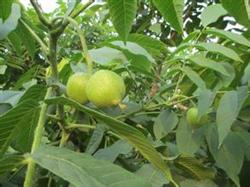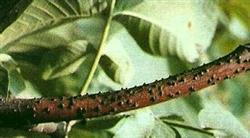Spring Management of Juglans regia

First, the planting of flax walnut trees. The suitable time for planting is from March to mid-April, after the soil is thawed and before the branches and buds germinate. Planting early is easy to survive and takes deep roots. Site selection should be considered according to the specific environmental requirements of walnut growth and development. The garden site had better choose sunny flat land and gentle slope land, the soil is suitable for sandy loam, and requires a soil layer of more than 1 meter, and the groundwater level is less than 2 meters from the surface. The planting area should be leveled and matured, and the work of alkali and waterlogging prevention should be done well. The mountain area can first repair the fish scale pit, and then gradually expand the tree plate. Be sure to dig a big hole and apply enough base fertilizer before planting. The correct way to dig a pit is to dig a large pit of 80 centimeters by 100 centimeters, separate the surface soil from the bottom soil, and apply circle fertilizer and organic fertilizer to each tree with a small cart (50 kilograms and 100 kilograms). When backfilling the tree pit, first fill the mixed soil of topsoil and bottom fertilizer, and then fill the bottom soil, fill it firmly while filling, and wait for planting after fully watering. two。 When planting finished seedlings, we should choose pure and excellent varieties. At present, the best ones are "white lion head", "nest bottom lion head", "big official cap" and so on. The seedlings planted should have well-developed main roots, complete lateral roots, no diseases and insect pests, more fibrous roots, strong branching power, and easy to form flower buds. If the seedlings are planted, if they are cultivated in the same year, they must be grafted in the same year, so that the survival rate is high and there is no injury after grafting. Second, the grafting of flax walnut trees. The choice of scion. Before selecting scion, the mother tree should be selected, and the mother tree should be a good variety tree with strong growth and no diseases and insect pests. The standard of qualified panicle is the developmental branch or fruit front branch of the mother tree which is 8 cm long and 1 cm thick and 2.5 cm thick. The branches are robust, fully developed, the pith is small, free of diseases and insect pests, and the bud eyes are mature and full. The time of collecting scion should be within 5 days before and after defoliation, or before spring bud sprouting. After the scion is collected, the wax seal should be cut off and stored in a bunker below 60 cm. two。 The choice of rootstocks. The selection of rootstocks should be based on the ecological conditions of the cultivated area and determine the appropriate rootstock types. If there are patches of Juglans mandshurica and edible walnut trees in the mountain area, the effect is better. The grafting site (rootstock pile) is mostly lateral branches or accessory branches, and the cross section of the anvil pile is less than 8 cm. Trees with a trunk of more than 10 cm had better choose 3-5 stumps for grafting to disperse bleeding, and the survival rate is relatively high. For example, if the tree is grafted in situ, it is best to cut off the root, so as to prevent the flow of injury and affect the survival rate. 3. Grafting time. The grafting time of walnut varies with different regional climatic conditions. All localities should decide the specific grafting period according to the local actual situation, and the split grafting is generally carried out in March. In the period from germination to leaf expansion of the rootstock (after 10 days of Ching Ming Festival), the growth began to accelerate, the rootstock ear did not leave the skin, and there was little or no bleeding, which was beneficial to the formation and survival of callus, and was suitable for skin-tongue grafting or skin grafting. If the nursery grafting, should be in early May to early June, green branch split grafting is appropriate. 4. Grafting method. Split grafting: suitable for rootstocks with older age, thicker seedling stem (more than 4 cm in diameter) and big trees changing heads. The rootstock of choice. Cut off 30 cm from the base of the stock, cut the saw, cut it vertically in the middle of the rootstock with a knife, about 5 cm deep, cut a symmetrical slope on each side of the scion, 4 cm long, and then quickly insert the scion into the split of the rootstock, so that the scion slope exposed 3 cm 7 cm, and make the rootstock form a close match. If the scion is thinner than the rootstock, the outer cambium should be aligned, the inner side of the scion should be retained, and then tightly bound with plastic strips to maintain interface humidity to facilitate healing. This grafting method is suitable for early grafting, and the cortex of the rootstock is not separated from the cortex. Bark tongue grafting: this method is suitable for tender young trees of 3cm and 5cm. After it is easy to leave the skin, choose the white and smooth place to cut off, flatten the saw, cut off the old skin at the scion, 5cm in length and 1cm in width, exposing the cortex. Cut the scion into a 6-8 cm long cutting surface, which is deeper than the pith, and then cut obliquely to ensure that the whole inclined plane changes from thick to thin, pinch the cortex behind the cutting surface with your fingers to separate it from the xylem, then insert the xylem of the scion between the xylem and the cortex of the rootstock, so that the cortex of the scion is covered on the cutting surface of the cortex of the rootstock, and finally tie the interface with plastic strips. Pay attention to not watering before, or 10 days before sawing off the rootstock to release water, in order to avoid excessive bleeding to reduce the survival rate. Skin insertion: first saw off the rootstock, flatten the saw, cut a knife vertically from top to bottom, deep to the xylem, about 2 cm long, and cut the cortex with the tip of the knife. The cutting method of the scion is to first cut one side into a large cutting surface, and exceed the central pith, obliquely cut 6cm to 8cm, insert the scion between the cortex of the rootstock and the xylem, so that the two layers connect, and wrap it with plastic strips. The above several connection methods, in order to avoid excessive bleeding, can be sawed dry to release water, or take root cutting and other measures. Third, spring management of hanging fruit trees 1. Water and fertilizer. From March to April, walnut trees begin to sprout, sprout and branch, and almost in a month, they need to complete the growth and development processes such as sprouting, branching, leaf spreading and flowering. At this time, when the northern spring drought and little rain season, should be combined with fertilization and irrigation. two。 For the trees entering the fruiting stage, some flower-promoting measures such as pulling branches and carving buds can be carried out on some main branches and auxiliary branches before budding in spring. The way to carve buds is to carve a bud in a different direction every two buds on both sides of the branch. Fourth, the prevention and control of diseases and insect pests. It is mainly caused by piercing and sucking pests in spring, and 10% imidacloprid wettable powder 2500-5000 times can be sprayed before Carya cathayensis germinates from March to April in spring. Scrape off the warped skin of the trunk to reveal the white green skin, the two semicircles are staggered, the width is 5cm 10cm, and apply 40% dimethoate emulsion 5x 10x liquid. two。 Walnut rot disease is the peak in spring and autumn in a year, especially from mid-April to mid-May. Trees with weak tree strength or severe freezing injury are easy to be infected with the disease. Can be combined with scraping off the old skin and disease spots, apply 100 times the liquid of Fumi arsine solution.
- Prev

Main technical measures for cultivating thick and strong seedlings of Carya cathayensis
In recent years, many farmers are optimistic about the planting of flax walnut trees, but they know little about their planting techniques. Not long ago, some fruit farmers asked about the irrigation of flax walnut trees. The author believes that if you want to plant a good flax walnut tree, there can be no shortage of water for five times. Water for the first time. In a year with normal rainfall, the first water is in late March, said.
- Next

Integrated Control of Walnut Branch Blight
Walnut branch blight is caused by fungal infection and mainly harms the branches. It occurs everywhere, the general disease plant rate is 20-30%, and the serious disease plant rate is more than 80%, causing a large number of branches to die, directly affecting the tree growth and the yield and quality of walnut. Therefore, it is necessary to timely prevent and control the disease and promote the tree.
Related
- Moge, come on! The staff of the peasant association in the producing area of cantaloupe were frightened when the crowd gathered.
- Causes and Solutions of low Fruit setting rate of Apple
- Symptoms and control measures of passion fruit virus disease
- Fruit growing lesson: how do apple orchards keep high yields?
- Can you build orchards in the mountains? What are the pros and cons?
- How to manage the coloring period of Crisson grape?
- This paper introduces the processing technology of two kinds of fig products.
- How much is a month for retired teachers in rural areas by 2020?
- How can strawberry planting increase sugar content? We should pay attention to management in many aspects.
- What are the cultivation techniques on how to improve the yield of golden fruit?

